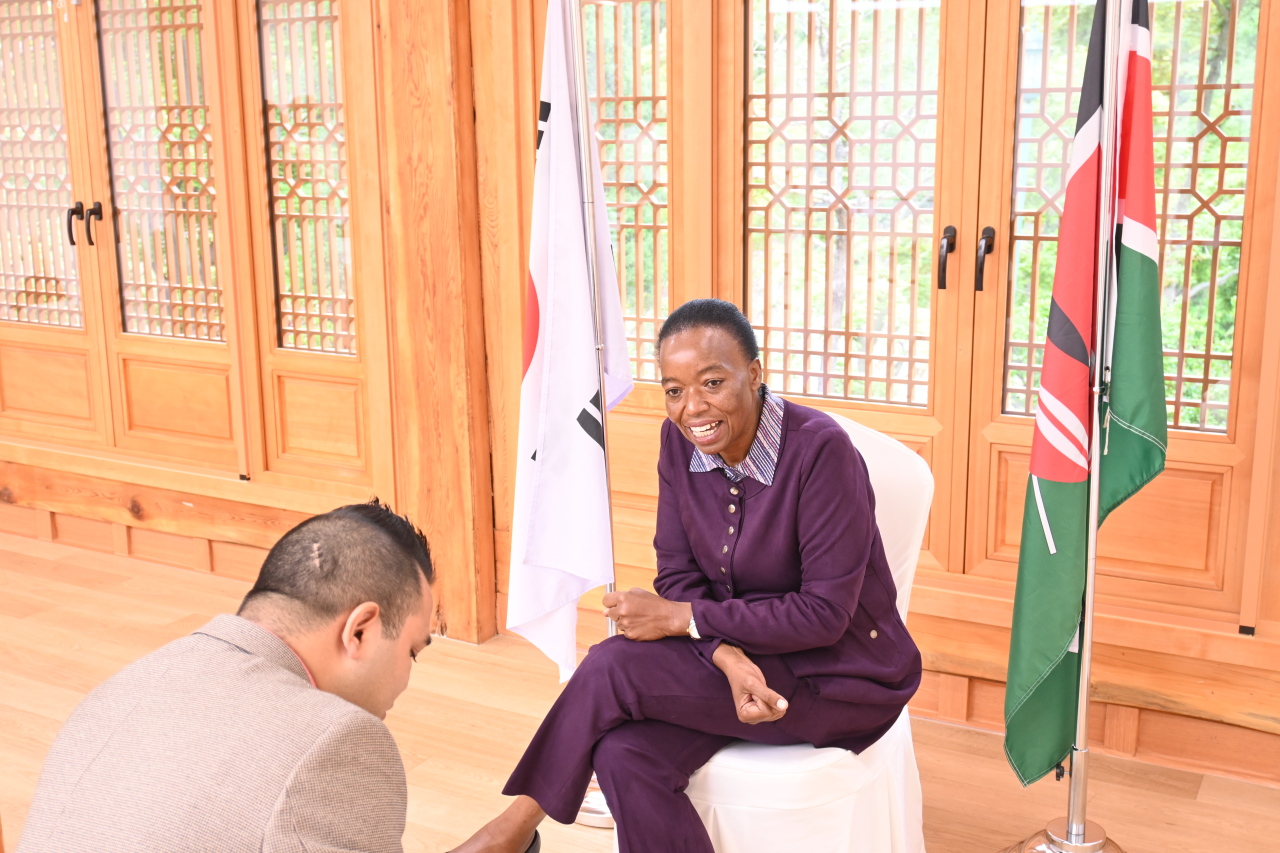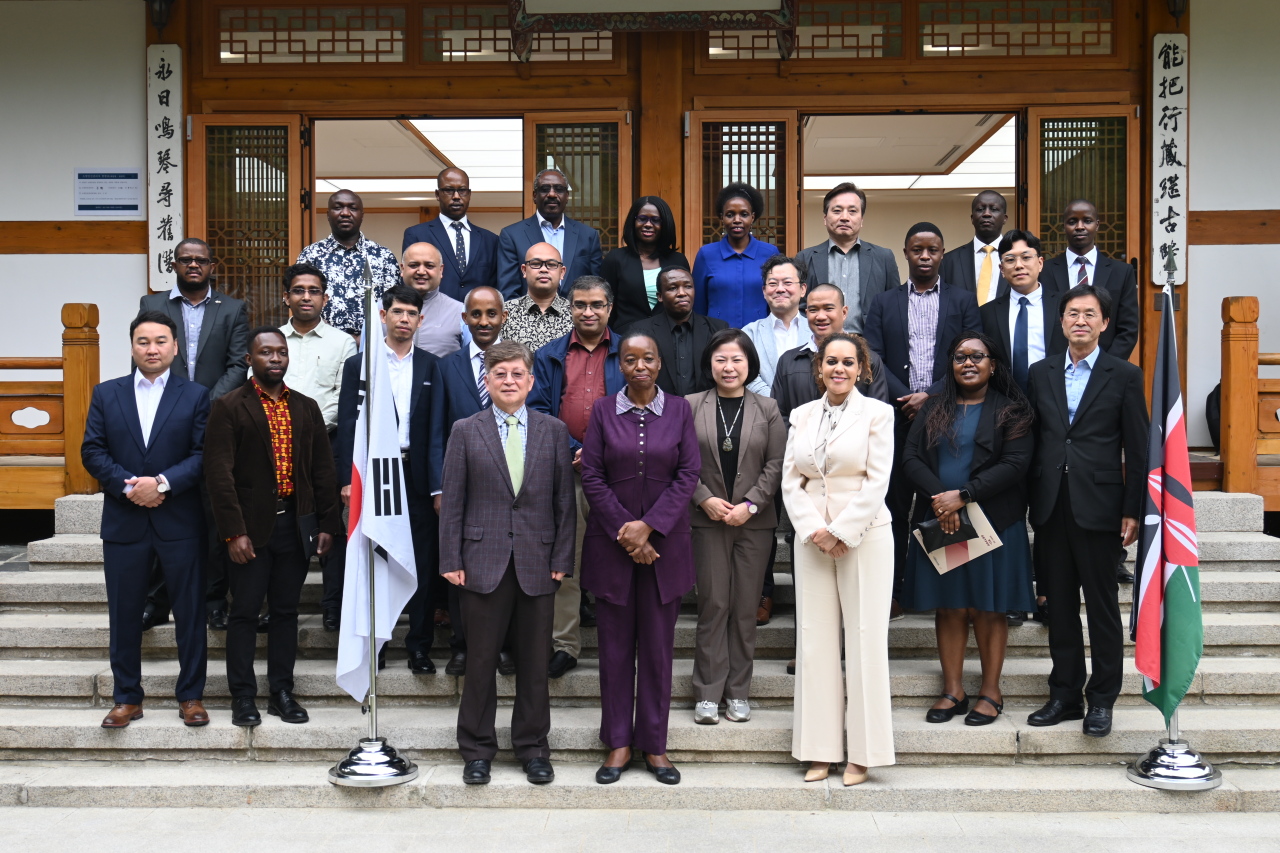Kenya and Korea can engage in energy sector cooperation: Kenyan minister
By Sanjay KumarPublished : May 17, 2022 - 11:19

Highlighting successful engineering, procurement and construction projects involving Korean firms in Kenya, Kenyan Energy Minister Monica Juma suggested more projects could follow in an interview with The Korea Herald on May 8.
“I am here to explore experiences and lessons from Korea that will help Kenya’s path to ongoing energy reform,” said Juma, who oversees the Kenyan Energy Ministry’s efforts to provide sustainable and affordable services.
Juma said Kenya Power -– a public liability company that owns and operates most of the electricity transmission and distribution system -– would be working closely with Korea Electric Power Corp. and other smart grid suppliers in Korea to modernize the Kenyan power grid system and reduce system losses.
“We had a number of meetings, including with Kepco, to see investment portfolio, exploring the possibility to work together to achieve the aspirations of Kenyans to go green,” Juma said.
According to the Kenyan minister, Kenya is seeking diversification of its power portfolio, and cooperation with Korea. Kenya plans to develop its first nuclear power plant before 2040 and is currently working on a technical and legal framework under International Atomic Energy Agency (IAEA) guidance, according to Juma.
“Korea has been a leader in nuclear power development, it is an area in which Kenya and Korea can continue cooperating,” Juma highlighted.
Juma cited Hyundai Engineering as an example of EPC contractor for Olkaria IV Geothermal Power plant -- the world’s single largest geothermal plant, located in Nakuru, Kenya.
She stressed Kenya would continue to invest, develop and expand geothermal power in the African region such as Ethiopia and Djibouti.
“It will give Korean companies more opportunities not only in Kenya but the whole region,” said Juma.
“I am here to explore experiences and lessons from Korea that will help Kenya’s path to ongoing energy reform,” said Juma, who oversees the Kenyan Energy Ministry’s efforts to provide sustainable and affordable services.
Juma said Kenya Power -– a public liability company that owns and operates most of the electricity transmission and distribution system -– would be working closely with Korea Electric Power Corp. and other smart grid suppliers in Korea to modernize the Kenyan power grid system and reduce system losses.
“We had a number of meetings, including with Kepco, to see investment portfolio, exploring the possibility to work together to achieve the aspirations of Kenyans to go green,” Juma said.
According to the Kenyan minister, Kenya is seeking diversification of its power portfolio, and cooperation with Korea. Kenya plans to develop its first nuclear power plant before 2040 and is currently working on a technical and legal framework under International Atomic Energy Agency (IAEA) guidance, according to Juma.
“Korea has been a leader in nuclear power development, it is an area in which Kenya and Korea can continue cooperating,” Juma highlighted.
Juma cited Hyundai Engineering as an example of EPC contractor for Olkaria IV Geothermal Power plant -- the world’s single largest geothermal plant, located in Nakuru, Kenya.
She stressed Kenya would continue to invest, develop and expand geothermal power in the African region such as Ethiopia and Djibouti.
“It will give Korean companies more opportunities not only in Kenya but the whole region,” said Juma.

Juma stressed Kenya’s focus on the green energy transition, including the development of off-shore wind and the integration of various renewables into the grid.
Kenya aims to scale down fossil-fuel power generation while using has as a transition fuel, and has plans for waste to energy projects and to start vehicle assembly for electric vehicles, the minister said.
“Kenya will adopt innovations in energy storage including green hydrogen to increase penetration levels of renewable energy and stabilization of the national electricity grid,” she said.
She highlighted that Kenya will increase electric vehicle use to reduce reliance on fossil fuels.
“Kenya is committed to attaining universal access to electricity by 2026 and to clean cooking by 2028,” she underlined, citing last mile connectivity to public institutions and far flung homesteads as an example of such projects.
“Appropriate policies and strategies were formulated to enhanced energy efficiency, and conservation through the Kenya National Electrification Strategy (KNES) strategies among others,” said Juma.
Discussing Kenya’s Nuclear Program road map, Juma did not rule out the advent of small modular reactors (SMRs) saying the first SMR construction will begin in 2028 and end in 2034.
“This will be followed by start-up tests beginning in 2035 to 2036,” Juma said.
Juma explained that renewable energy already accounted for 73 percent of Kenya’s electricity capacity and 93 percent of power supplied.
Kenya aims to scale down fossil-fuel power generation while using has as a transition fuel, and has plans for waste to energy projects and to start vehicle assembly for electric vehicles, the minister said.
“Kenya will adopt innovations in energy storage including green hydrogen to increase penetration levels of renewable energy and stabilization of the national electricity grid,” she said.
She highlighted that Kenya will increase electric vehicle use to reduce reliance on fossil fuels.
“Kenya is committed to attaining universal access to electricity by 2026 and to clean cooking by 2028,” she underlined, citing last mile connectivity to public institutions and far flung homesteads as an example of such projects.
“Appropriate policies and strategies were formulated to enhanced energy efficiency, and conservation through the Kenya National Electrification Strategy (KNES) strategies among others,” said Juma.
Discussing Kenya’s Nuclear Program road map, Juma did not rule out the advent of small modular reactors (SMRs) saying the first SMR construction will begin in 2028 and end in 2034.
“This will be followed by start-up tests beginning in 2035 to 2036,” Juma said.
Juma explained that renewable energy already accounted for 73 percent of Kenya’s electricity capacity and 93 percent of power supplied.

The minister also spoke about Kenya’s hydrogen development program working on production of green hydrogen using extra capacity in its grids, especially at night during low electricity demand in the short to medium term.
She said Kenya started identifying industrial pathways to further pursue green hydrogen use as energy carrier for selected transport (mobility) options.
She highlighted efforts to use hydrogen, methanol or ammonia as way to convey energy off-grid, green steel production, and the production of nitrogen content of fertilizers for existing and new regional industrial processes.
According to Juma, a well-structured approach is under way to efficiently develop the green hydrogen market, including green hydrogen strategy leading to a reliable and comprehensive policy and regulatory framework, pilot and research projects of different sizes, and building up expertise in Kenya through research, development innovation, and education.
“We are also in the process of creating a Kenyan Energy white paper which will determine the pathway to future,” highlighted Juma.
“We have been looking at the entire value chain system in terms of planning, transmission, generation and distribution of power not for individual use but also for economic activity,” concluded Juma.
She said Kenya started identifying industrial pathways to further pursue green hydrogen use as energy carrier for selected transport (mobility) options.
She highlighted efforts to use hydrogen, methanol or ammonia as way to convey energy off-grid, green steel production, and the production of nitrogen content of fertilizers for existing and new regional industrial processes.
According to Juma, a well-structured approach is under way to efficiently develop the green hydrogen market, including green hydrogen strategy leading to a reliable and comprehensive policy and regulatory framework, pilot and research projects of different sizes, and building up expertise in Kenya through research, development innovation, and education.
“We are also in the process of creating a Kenyan Energy white paper which will determine the pathway to future,” highlighted Juma.
“We have been looking at the entire value chain system in terms of planning, transmission, generation and distribution of power not for individual use but also for economic activity,” concluded Juma.












![[Today’s K-pop] BTS pop-up event to come to Seoul](http://res.heraldm.com/phpwas/restmb_idxmake.php?idx=644&simg=/content/image/2024/04/17/20240417050734_0.jpg&u=)





![[KH Explains] Hyundai's full hybrid edge to pay off amid slow transition to pure EVs](http://res.heraldm.com/phpwas/restmb_idxmake.php?idx=652&simg=/content/image/2024/04/18/20240418050645_0.jpg&u=20240419100350)

![[Today’s K-pop] Zico drops snippet of collaboration with Jennie](http://res.heraldm.com/phpwas/restmb_idxmake.php?idx=642&simg=/content/image/2024/04/18/20240418050702_0.jpg&u=)